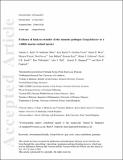Files in this item
Evidence of land-sea transfer of the zoonotic pathogen Campylobacter to a wildlife marine sentinel species
Item metadata
| dc.contributor.author | Baily, J.L. | |
| dc.contributor.author | Méric, G. | |
| dc.contributor.author | Bayliss, S. | |
| dc.contributor.author | Foster, G. | |
| dc.contributor.author | Moss, S.E. | |
| dc.contributor.author | Watson, E. | |
| dc.contributor.author | Pascoe, B. | |
| dc.contributor.author | Mikhail, J. | |
| dc.contributor.author | Pizzi, R. | |
| dc.contributor.author | Goldstone, R.J. | |
| dc.contributor.author | Smith, D.G.E. | |
| dc.contributor.author | Willoughby, K. | |
| dc.contributor.author | Hall, A.J. | |
| dc.contributor.author | Sheppard, S.K. | |
| dc.contributor.author | Dagleish, M.P. | |
| dc.date.accessioned | 2016-01-05T10:06:58Z | |
| dc.date.available | 2016-01-05T10:06:58Z | |
| dc.date.issued | 2015-01 | |
| dc.identifier.citation | Baily , J L , Méric , G , Bayliss , S , Foster , G , Moss , S E , Watson , E , Pascoe , B , Mikhail , J , Pizzi , R , Goldstone , R J , Smith , D G E , Willoughby , K , Hall , A J , Sheppard , S K & Dagleish , M P 2015 , ' Evidence of land-sea transfer of the zoonotic pathogen Campylobacter to a wildlife marine sentinel species ' , Molecular Ecology , vol. 24 , no. 1 , pp. 208-221 . https://doi.org/10.1111/mec.13001 | en |
| dc.identifier.issn | 0962-1083 | |
| dc.identifier.other | PURE: 164424155 | |
| dc.identifier.other | PURE UUID: af2e1a90-dcbc-4261-b7dd-68fbc8083f47 | |
| dc.identifier.other | Scopus: 84920772526 | |
| dc.identifier.other | WOS: 000347446300015 | |
| dc.identifier.other | ORCID: /0000-0002-7562-1771/work/47136297 | |
| dc.identifier.uri | https://hdl.handle.net/10023/7956 | |
| dc.description | This work and JLB's PhD studentship were funded by the Moredun Research Institute and the Royal Zoological Society of Scotland. SKS is funded by the Biotechnology and Biological Sciences Research Council (BBSRC), the Medical Research Council (MR/L015080/1) and the Wellcome Trust. Date of Acceptance: 13/11/2014 | en |
| dc.description.abstract | Environmental pollution often accompanies the expansion and urbanization of human populations where sewage and wastewaters commonly have an impact on the marine environments. Here, we explored the potential for faecal bacterial pathogens, of anthropic origin, to spread to marine wildlife in coastal areas. The common zoonotic bacterium Campylobacter was isolated from grey seals (Halichoerus grypus), an important sentinel species for environmental pollution, and compared to isolates from wild birds, agricultural sources and clinical samples to characterize possible transmission routes. Campylobacter jejuni was present in half of all grey seal pups sampled (24/50 dead and 46/90 live pups) in the breeding colony on the Isle of May (Scotland), where it was frequently associated with histological evidence of disease. Returning yearling animals (19/19) were negative for C. jejuni suggesting clearance of infection while away from the localized colony infection source. The genomes of 90 isolates from seals were sequenced and characterized using a whole-genome multilocus sequence typing (MLST) approach and compared to 192 published genomes from multiple sources using population genetic approaches and a probabilistic genetic attribution model to infer the source of infection from MLST data. The strong genotype-host association has enabled the application of source attribution models in epidemiological studies of human campylobacteriosis, and here assignment analyses consistently grouped seal isolates with those from human clinical samples. These findings are consistent with either a common infection source or direct transmission of human campylobacter to grey seals, raising concerns about the spread of human pathogens to wildlife marine sentinel species in coastal areas. | |
| dc.format.extent | 14 | |
| dc.language.iso | eng | |
| dc.relation.ispartof | Molecular Ecology | en |
| dc.rights | This is the peer reviewed version of the following article: Evidence of land-sea transfer of the zoonotic pathogen Campylobacter to a wildlife marine sentinel species Baily, J. L., Méric, G., Bayliss, S., Foster, G., Moss, S. E., Watson, E., Pascoe, B., Mikhail, J., Pizzi, R., Goldstone, R. J., Smith, D. G. E., Willoughby, K., Hall, A. J., Sheppard, S. K. & Dagleish, M. P. Jan 2015 In : Molecular Ecology. 24, 1, p. 208-221, which has been published in final form at http://dx.doi.org/10.1111/mec.13001. This article may be used for non-commercial purposes in accordance with Wiley Terms and Conditions for Self-Archiving. | en |
| dc.subject | Campylobacter | en |
| dc.subject | Environmental health | en |
| dc.subject | Genomics | en |
| dc.subject | Grey seals | en |
| dc.subject | Source attribution | en |
| dc.subject | QL Zoology | en |
| dc.subject | QH301 Biology | en |
| dc.subject | NDAS | en |
| dc.subject | SDG 3 - Good Health and Well-being | en |
| dc.subject | SDG 14 - Life Below Water | en |
| dc.subject.lcc | QL | en |
| dc.subject.lcc | QH301 | en |
| dc.title | Evidence of land-sea transfer of the zoonotic pathogen Campylobacter to a wildlife marine sentinel species | en |
| dc.type | Journal article | en |
| dc.contributor.sponsor | NERC | en |
| dc.description.version | Postprint | en |
| dc.contributor.institution | University of St Andrews. School of Biology | en |
| dc.contributor.institution | University of St Andrews. Sea Mammal Research Unit | en |
| dc.contributor.institution | University of St Andrews. Marine Alliance for Science & Technology Scotland | en |
| dc.contributor.institution | University of St Andrews. Scottish Oceans Institute | en |
| dc.identifier.doi | https://doi.org/10.1111/mec.13001 | |
| dc.description.status | Peer reviewed | en |
| dc.date.embargoedUntil | 2015-12-31 | |
| dc.identifier.url | http://onlinelibrary.wiley.com/doi/10.1111/mec.13001/suppinfo | en |
| dc.identifier.grantnumber | Agreement R8-H12-86 | en |
This item appears in the following Collection(s)
Items in the St Andrews Research Repository are protected by copyright, with all rights reserved, unless otherwise indicated.

